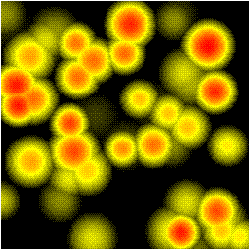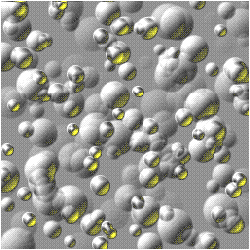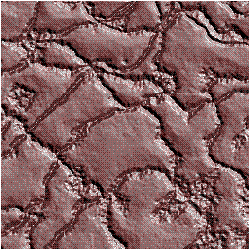| Laboratory for Statistical Physics and Collective Phenomena |
|
Introduction Welcome to the Laboratory for Statistical Physics and Collective Phenomena. [ Para una introducción en español ]. Our laboratory was created in August 15th 1996 and its main objective is to study the complex behavior of nature at three major scales in a cross-disciplinary fashion:
|
 Microscopic,
where theories for molecular, atomic, nuclear
and subnuclear phenomena are considered in a combined approach of
statistical mechanics, quantum mechanics and field quantum field theory. In
our laboratory there is a special interest to develop and understand the
natural extensions of concepts like interfacial tension, friction and
viscosity to nuclear and subnuclear scales. The information contained in the
fragmentation processes in molecular, atomic, nuclear and subnuclear
collisions can be analyzed through very powerful and elegant tools related
to fractal measure theory. Stability of nuclear systems is reviewed within
the context of nonlinear density dependent alpha particle models based on
Skyrme-like effective forces. Chaos and self-organization features are
revisited for these systems. Collective excitations of continuum in very
light nuclei are studied under a relativistic approach with scalar and
vectorial nucleon-nucleus optical potentials.
Microscopic,
where theories for molecular, atomic, nuclear
and subnuclear phenomena are considered in a combined approach of
statistical mechanics, quantum mechanics and field quantum field theory. In
our laboratory there is a special interest to develop and understand the
natural extensions of concepts like interfacial tension, friction and
viscosity to nuclear and subnuclear scales. The information contained in the
fragmentation processes in molecular, atomic, nuclear and subnuclear
collisions can be analyzed through very powerful and elegant tools related
to fractal measure theory. Stability of nuclear systems is reviewed within
the context of nonlinear density dependent alpha particle models based on
Skyrme-like effective forces. Chaos and self-organization features are
revisited for these systems. Collective excitations of continuum in very
light nuclei are studied under a relativistic approach with scalar and
vectorial nucleon-nucleus optical potentials. |
|
 Mesoscopic,
where particular details of objects at
microscopic scales are disregarded and these microscopic complex objects
become the new building blocks of even bigger objects. This simplification
is not going to change the essential physics behind those systems at
intermediate scales.Within that scale range, problems related to molecules
and their interactions, chemical reactions and their kinetics, interfacial
phenomena, colloid and dispersion physics, transport phenomena in disordered
media, aggregation phenomena, physics of nanostructures, chaos and
self-organization at intermediate scales and cellular cooperative phenomena
like bacteria, tumor and normal tissue growth, immunological and neural
networks related to physiological systems and their interactions, are going
to be studied following a very cross-disciplinary approach.
Mesoscopic,
where particular details of objects at
microscopic scales are disregarded and these microscopic complex objects
become the new building blocks of even bigger objects. This simplification
is not going to change the essential physics behind those systems at
intermediate scales.Within that scale range, problems related to molecules
and their interactions, chemical reactions and their kinetics, interfacial
phenomena, colloid and dispersion physics, transport phenomena in disordered
media, aggregation phenomena, physics of nanostructures, chaos and
self-organization at intermediate scales and cellular cooperative phenomena
like bacteria, tumor and normal tissue growth, immunological and neural
networks related to physiological systems and their interactions, are going
to be studied following a very cross-disciplinary approach.
|
|
 Macroscopic,
where the objects to be studied belong to a
human or even bigger scale.The main subject to be considered is continuous
media theory, including fluid mechanics and dynamics, the related transport
phenomena and self-organization at large scales. Special attention is
devoted to the combination of gauge, elasticity and defect theories applied
to the study of fracture and deformation of material media. The solution of
inverse problems related to wave propagation phenomena in media of different
nature and the role of time scales in the continuous media characterization
is another topic of interest. Stochastic methods based on simulated annealing
procedures are used in the inversion of Laplace and Stieltjes transforms.
Particular applications to nuclear physics, relaxometry in nuclear magnetic
resonance, medical physics, geophysics, transport phenomena in porous media
and dispersions are now in progress.
Macroscopic,
where the objects to be studied belong to a
human or even bigger scale.The main subject to be considered is continuous
media theory, including fluid mechanics and dynamics, the related transport
phenomena and self-organization at large scales. Special attention is
devoted to the combination of gauge, elasticity and defect theories applied
to the study of fracture and deformation of material media. The solution of
inverse problems related to wave propagation phenomena in media of different
nature and the role of time scales in the continuous media characterization
is another topic of interest. Stochastic methods based on simulated annealing
procedures are used in the inversion of Laplace and Stieltjes transforms.
Particular applications to nuclear physics, relaxometry in nuclear magnetic
resonance, medical physics, geophysics, transport phenomena in porous media
and dispersions are now in progress. |
For more information you are welcome to check our laboratory general directory or you may send your questions to the following E-mail address: rmartin@fisica.ciens.ucv.ve
Laboratory General Directory |
|
|

 Microscopic,
where theories for molecular, atomic, nuclear
and subnuclear phenomena are considered in a combined approach of
statistical mechanics, quantum mechanics and field quantum field theory. In
our laboratory there is a special interest to develop and understand the
natural extensions of concepts like interfacial tension, friction and
viscosity to nuclear and subnuclear scales. The information contained in the
fragmentation processes in molecular, atomic, nuclear and subnuclear
collisions can be analyzed through very powerful and elegant tools related
to fractal measure theory. Stability of nuclear systems is reviewed within
the context of nonlinear density dependent alpha particle models based on
Skyrme-like effective forces. Chaos and self-organization features are
revisited for these systems. Collective excitations of continuum in very
light nuclei are studied under a relativistic approach with scalar and
vectorial nucleon-nucleus optical potentials.
Microscopic,
where theories for molecular, atomic, nuclear
and subnuclear phenomena are considered in a combined approach of
statistical mechanics, quantum mechanics and field quantum field theory. In
our laboratory there is a special interest to develop and understand the
natural extensions of concepts like interfacial tension, friction and
viscosity to nuclear and subnuclear scales. The information contained in the
fragmentation processes in molecular, atomic, nuclear and subnuclear
collisions can be analyzed through very powerful and elegant tools related
to fractal measure theory. Stability of nuclear systems is reviewed within
the context of nonlinear density dependent alpha particle models based on
Skyrme-like effective forces. Chaos and self-organization features are
revisited for these systems. Collective excitations of continuum in very
light nuclei are studied under a relativistic approach with scalar and
vectorial nucleon-nucleus optical potentials. Mesoscopic,
where particular details of objects at
microscopic scales are disregarded and these microscopic complex objects
become the new building blocks of even bigger objects. This simplification
is not going to change the essential physics behind those systems at
intermediate scales.Within that scale range, problems related to molecules
and their interactions, chemical reactions and their kinetics, interfacial
phenomena, colloid and dispersion physics, transport phenomena in disordered
media, aggregation phenomena, physics of nanostructures, chaos and
self-organization at intermediate scales and cellular cooperative phenomena
like bacteria, tumor and normal tissue growth, immunological and neural
networks related to physiological systems and their interactions, are going
to be studied following a very cross-disciplinary approach.
Mesoscopic,
where particular details of objects at
microscopic scales are disregarded and these microscopic complex objects
become the new building blocks of even bigger objects. This simplification
is not going to change the essential physics behind those systems at
intermediate scales.Within that scale range, problems related to molecules
and their interactions, chemical reactions and their kinetics, interfacial
phenomena, colloid and dispersion physics, transport phenomena in disordered
media, aggregation phenomena, physics of nanostructures, chaos and
self-organization at intermediate scales and cellular cooperative phenomena
like bacteria, tumor and normal tissue growth, immunological and neural
networks related to physiological systems and their interactions, are going
to be studied following a very cross-disciplinary approach. Macroscopic,
where the objects to be studied belong to a
human or even bigger scale.The main subject to be considered is continuous
media theory, including fluid mechanics and dynamics, the related transport
phenomena and self-organization at large scales. Special attention is
devoted to the combination of gauge, elasticity and defect theories applied
to the study of fracture and deformation of material media. The solution of
inverse problems related to wave propagation phenomena in media of different
nature and the role of time scales in the continuous media characterization
is another topic of interest. Stochastic methods based on simulated annealing
procedures are used in the inversion of Laplace and Stieltjes transforms.
Particular applications to nuclear physics, relaxometry in nuclear magnetic
resonance, medical physics, geophysics, transport phenomena in porous media
and dispersions are now in progress.
Macroscopic,
where the objects to be studied belong to a
human or even bigger scale.The main subject to be considered is continuous
media theory, including fluid mechanics and dynamics, the related transport
phenomena and self-organization at large scales. Special attention is
devoted to the combination of gauge, elasticity and defect theories applied
to the study of fracture and deformation of material media. The solution of
inverse problems related to wave propagation phenomena in media of different
nature and the role of time scales in the continuous media characterization
is another topic of interest. Stochastic methods based on simulated annealing
procedures are used in the inversion of Laplace and Stieltjes transforms.
Particular applications to nuclear physics, relaxometry in nuclear magnetic
resonance, medical physics, geophysics, transport phenomena in porous media
and dispersions are now in progress.